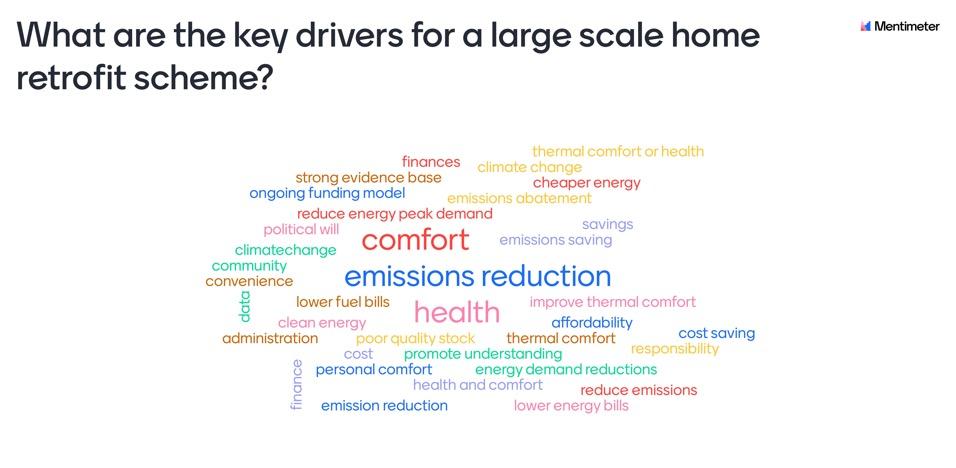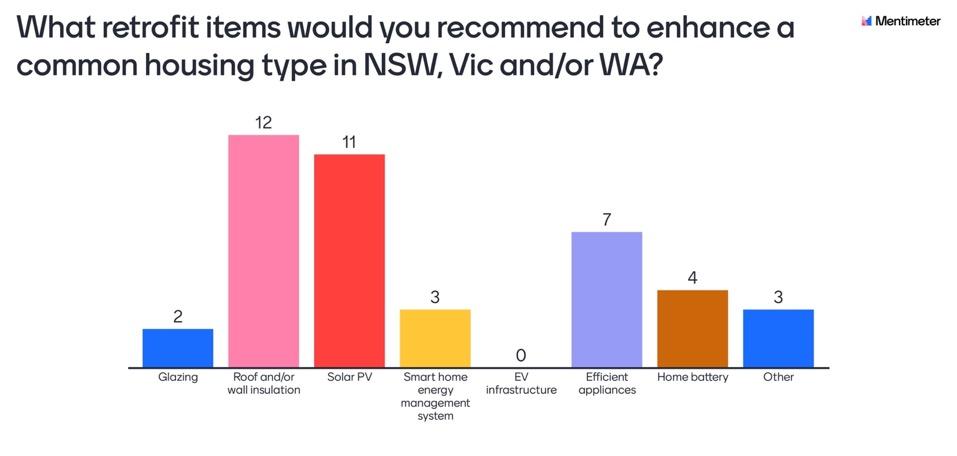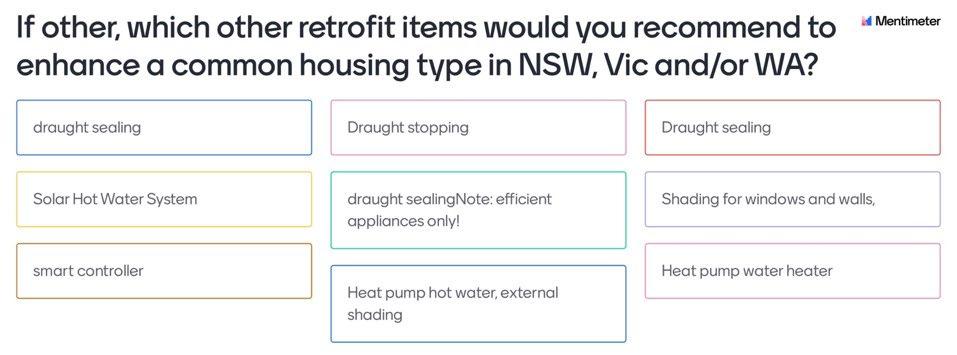
6 minute read
Retrofit Aims and Priorities
• To reduce homeowner costs, a community focussed large-scale home retrofit scheme would aim to enable labour and product buying power through larger contracts and increased quantities of material thus finding efficiencies of scale and bulk discounts in supplying and installing the retrofit items • The ability to perform true cost benefit analysis will be enabled through case-study home retrofits of different housing types in different states/climates across
Australia • The bespoke nature of each retrofit and existing Australian homes means that a cost benefit analysis for different housing types will be a beneficial way to measure and monitor the benefit of the large-scale home retrofit scheme, as it progresses
Retrofit Aims and Priorities
Through the IRG workshop discussion and interviews the aims and priorities of the largescale home retrofit scheme were explored. This was done through a Mentimeter survey, as well as through facilitated discussion via Miro.
4.5.1 Retrofit Aims
The IRG highlighted the importance of considering and setting clear goals for the retrofit scheme as it would guide the selection of retrofit items and aid communication about the scheme. “A lot of this depends on the goals of the program as well, is it increasing the speed and scale of retrofits within a period of time or widespread take up?” Figure 3 shows that comfort and emissions reductions stood out among the respondents from the IRG as priority drivers for a large-scale home retrofit scheme. Cost savings or lower energy bills were also a consideration although not found to be as high a priority due to the greater impact and benefits created by prioritising the improvement of health and comfort for homeowners/occupants and the increased reduction of carbon emissions. It was noted that “National Construction Code (NCC) is driving home comfort as a priority driver over energy cost off set. Thermal comfort for achieving suitable ratings cannot be compromised by fitting Photo-Voltaics.”
Figure 3 Key drivers for a large-scale home retrofit scheme identified by IRG
4.5.2 Retrofit Priorities
The importance of assessment and alignment with NatHERS
IRG members emphasised that whole of home assessments play a vital role in the process of retrofitting existing homes: “A very good enthusiastic assessor is required”, that the scheme should “Use of robust assessment tool to determine which upgrades to perform” and that the scheme should “undertake assessments early in discussions”. Several members of the IRG noted the current activity around the National Scorecard and the extension to NatHERS for existing homes and recommended aligning with this work: “Strongly recommend using the NatHERS existing homes program for assessors - and get a rating. It will eventually link to disclosure and the broader financial sector”. It was noted that “the Scorecard can be used to model the impact of upgrades”. In addition, assessments would provide data (that is currently lacking in most states) to better understand the quality of existing housing stock in Australia and is a basis to provide sound technical guidance to the homeowner on what retrofit to undertake. Beyond the benefits of the assessment, it was also noted that the assessors perform a key role in supporting homeowners to understand retrofits. “Well trained assessors will be able to explain the unique situation in a house, and the dynamic between appliances and house structure / design.”
The priority of retrofit items
Within the IRG workshops participants were asked, via a survey about priority retrofit items that they would like to see form part of a large-scale home retrofit scheme. They strongly felt that insulation and draught proofing should be high priority items due to their effectiveness when installed correctly. This is supported in the literature review. However, it is also worth noting that to enable a healthy and thermally comfortable
home, ventilation must be considered especially where airflow has been decreased to prevent the growth of mould, and where gas appliances are still present, not create an uninhabitable space. This is recommended as part of a further research question to consider how to not decrease the homes indoor air quality (IAQ) through increased building air tightness. Regardless of the limited effect of insulation on cost and emissions, in particular where heating is done with gas, it is essential to underline that insulation is critical to improving healthier and more comfortable homes. Indeed, insulation can lead to a significantly warmer and drier indoor environment, resulting in decreased mould formation and related respiratory symptoms alongside many other diseases (Howden-Chapman et al., 2012). In addition, a cost benefit analysis of the Warm Up New Zealand: Heat Smart Programme conducted by Grimes et al (2012) gave the following recommendations for future programs: • Prioritise the insulation component of the programme relative to the clean heating component of the programme. • Target clean heating to houses that use reticulated gas rather than electricity for heating prior to treatment. • Target insulation to houses in cooler rather than warmer areas. • Target insulation to low- and middle-income earners and other at-risk groups in terms of illness. The Irish IERC report (IERC, 2021) on co-benefits of retrofits highlights the cost of heat pumps as a retrofit. The cost of running a heat pump in an energy inefficient home could be expensive. Therefore, the installation of a heat pump should be done in conjunction with other measures such as increasing levels of insulation and draughtproofing for example.

Figure 4 Recommended retrofit items as voted by the IRG

Figure 5 Detail of ‘other’ retrofit items as voted by IRG
4.5.3 Quality Assurance
IRG participants and the literature review were very clear, “Poor compliance could derail the whole scheme.”
Quality assurance and safety is critical to the success of a large-scale home retrofit scheme. The quality of retrofits and the safety of workers will depend on the use of trained and accredited workers as well as certified materials and equipment only. “Industry needs a rigorous training and certification scheme for all retrofit providers.” This provides an opportunity to enable the clean energy workforce of the future through industry focussed training and accreditation. “The customer needs to be able to trust the program provider and parties involved. ” Ensuring and maintaining the quality of retrofits will grow trust among homeowners and would enable ‘word of mouth’ recommendations amongst communities. Enabling a quality assurance process for the scheme, homeowner and contractor ensures standards remain high and consistent across the scheme. “Audit 10% of upgrades to ensure standard of work delivered and require a desk top audit from the contractor on completion of every job, including photos. ”
4.5.4 Scheme Design
Pilot schemes will be required to test and tweak the scheme design and the delivery model where required. The pilot must be able to “trial and understand the complexities of the upgrade work being completed and enable something within the process to support those high priority retrofit items so that minor issues don’t make them too hard” for a large-scale home retrofit scheme to deliver.
“Homeowners want a streamlined process from assessment to finance and installation, and quality assurance included. ” Understanding the needs and wants of the target market is







